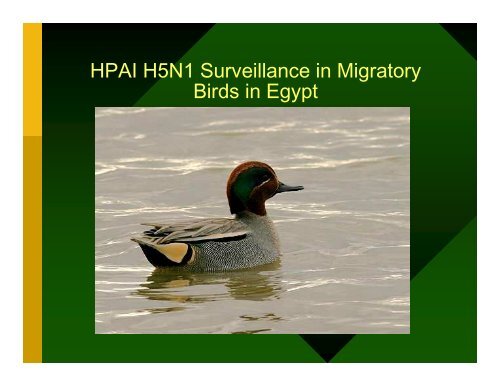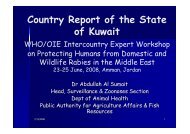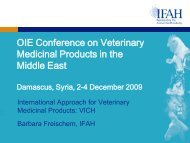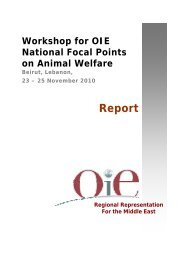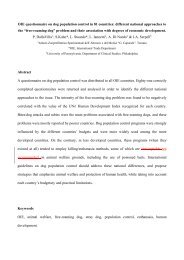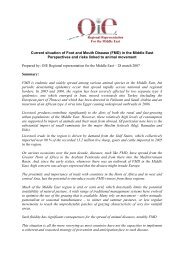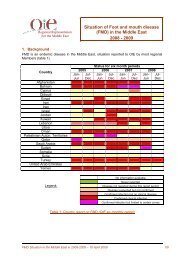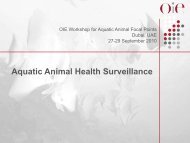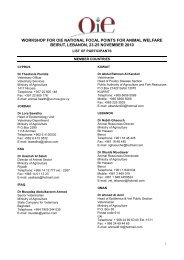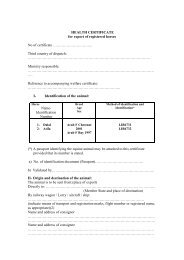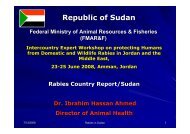HPAI H5N1 Surveillance in Migratory Birds in Egypt - Middle East
HPAI H5N1 Surveillance in Migratory Birds in Egypt - Middle East
HPAI H5N1 Surveillance in Migratory Birds in Egypt - Middle East
- No tags were found...
You also want an ePaper? Increase the reach of your titles
YUMPU automatically turns print PDFs into web optimized ePapers that Google loves.
Avian Influenza <strong>in</strong> <strong>Migratory</strong> <strong>Birds</strong>M<strong>in</strong>istry of Environment of <strong>Egypt</strong>Naval Medical Research Unit 3
Avian Influenza <strong>in</strong> <strong>Migratory</strong> <strong>Birds</strong> Avian <strong>in</strong>fluenza, which is caused by Influenza Aviruses, can affect a variety of domestic and wildbird species. Avian <strong>in</strong>fluenza viruses are ubiquitous and arema<strong>in</strong>ta<strong>in</strong>ed <strong>in</strong> nature by aquatic birds, ma<strong>in</strong>ly of theorders Anseriformes and Charadriiformes.
Blad4Beantwoord<strong>in</strong>g vragen uit de Annex1. Dient het toekomstige toezicht zich naar uw oordeel nog uit te strekkentot andere organisaties dan die welke <strong>in</strong> de voorgestelde bijlage bij hetwetsvoorstel zijn genoemd?Het plaatsen onder het toezicht betekent <strong>in</strong> feite een erkenn<strong>in</strong>g van debeheersorganisaties. De wetgever zal dit moeten onderbouwen, ook voorhet vrijwillig collectief beheer. Dat betekent dat <strong>in</strong> de wet criteria moetenworden geëxpliciteerd waaraan collectieve beheersorganisaties moetenvoldoen om erkend te worden en dus met recht en rede bij gebruikers aante komen. Mogelijke criteria zijn dan:− legitimiteit door openbaarmak<strong>in</strong>g van de contracten metrechthebbenden waar<strong>in</strong> de uitoefen<strong>in</strong>g van die rechten door decollectieve beheersorganisatie zijn vastgelegd;−−−−−transparantie t.a.v. wie vertegenwoordigd worden en wie niet;eisen t.a.v. governance: onafhankelijk beheer, representatierechthebbenden / gebruikers bij het <strong>in</strong>terne toezicht op debeheersorganisatie;transparantie <strong>in</strong> de tariefopbouw, met tarieven gebaseerd op hetfeitelijk gebruik van het recht;transparantie t.a.v. repartitie;normer<strong>in</strong>g van de uitvoer<strong>in</strong>gskosten als percentage van de omzet.Indien niet aan deze eisen wordt voldaan, zullen rechthebbenden voor debetal<strong>in</strong>g van de gebruikmak<strong>in</strong>g van hun rechten zijn aangewezen op eenwel erkende organisatie. Nader zal moeten worden bezien of en <strong>in</strong>hoeverre aanvullend moet worden voorzien <strong>in</strong> een publiekevangnetvoorzien<strong>in</strong>g.De te stellen wettelijke eisen moeten ook gelden voor buitenlandseorganisaties die zich op de Nederlandse markt begeven. In het kader vanhet door Brussel <strong>in</strong> gang gezette beleid tot liberaliser<strong>in</strong>g van collectiefbeheer voor muziekrechten wordt aan auteurs en muziekuitgevers devrijheid gelaten om een collectieve beheersorganisatie uit een anderlidstaat te kiezen voor het beheer <strong>in</strong> ook Nederland, zonder dat hierbij dehuidige praktijk van wederkerige vertegenwoordig<strong>in</strong>g wordt gebruikt. Ditbetekent dat meer partijen zich op de Nederlandse markt met collectiefmuziekbeheer kunnen gaan bezighouden.
Avian Influenza <strong>in</strong> <strong>Migratory</strong> <strong>Birds</strong> S<strong>in</strong>ce its appearance <strong>in</strong> 1996 <strong>in</strong> a domestic goose <strong>in</strong>Guangdong Prov<strong>in</strong>ce, People's Republic of Ch<strong>in</strong>a, avian<strong>in</strong>fluenza <strong>in</strong> humans caused by the highly pathogenic avian<strong>in</strong>fluenza (<strong>HPAI</strong>) subtype <strong>H5N1</strong> has repeatedly beenportrayed as one of the most prom<strong>in</strong>ent emerg<strong>in</strong>g diseasethreat faced by humanity.
Avian Influenza <strong>in</strong> <strong>Egypt</strong> <strong>Egypt</strong> rema<strong>in</strong>s the most affected country outside Asia. Amongthe 379 cases reported globally to WHO by the end of March2008, <strong>Egypt</strong> represented 12.7% of the global number ofcases, follow<strong>in</strong>g Indonesia (35%) and Vietnam (28%). The exposure to sick/dead poultry from backyard flocks hasbeen determ<strong>in</strong>ed for almost all the cases confirmed <strong>in</strong> <strong>Egypt</strong>(45/47).
Flyways of migratory birds It has been suggested that migratory birds have played a role <strong>in</strong><strong>HPAI</strong> <strong>H5N1</strong> rapid dispersal across cont<strong>in</strong>ents
<strong>Migratory</strong> birds surveillance
AI <strong>Surveillance</strong> <strong>in</strong> <strong>Migratory</strong> <strong>Birds</strong> <strong>in</strong> <strong>Egypt</strong> Objective To detect the presence of<strong>HPAI</strong> <strong>H5N1</strong> <strong>in</strong> migratorybirds <strong>in</strong> <strong>Egypt</strong>. Collaborative effortbetween the M<strong>in</strong>istry ofEnvironment of <strong>Egypt</strong> andNAMRU-3
AI <strong>Surveillance</strong> <strong>in</strong> <strong>Migratory</strong> <strong>Birds</strong> <strong>in</strong> <strong>Egypt</strong>Collection sites: Port Said Damietta El Fayoum Al Arish Sharm El Sheik Rasheed Ash Sharqiyah Rashid Aswan
AI <strong>Surveillance</strong> <strong>in</strong> <strong>Migratory</strong> <strong>Birds</strong> <strong>in</strong> <strong>Egypt</strong>1Alexandria52346879= 1 case, 2006= 1 case, 2007= 1 case, 200810Cairo11121 = KafrEl Sheikh2 = Gharbia3 = Menofia4 = Qalubiya5 = Behera6 = Damietta7 = Dakahlia8 = Sharkia9 = Cairo10 = Fayoum11 = BeniSuef12 = Menia13 = Sohag14 = Qena15 = AswanAswan131415Geographical location of the<strong>HPAI</strong> <strong>H5N1</strong> human casesGeographical locations of thecollection sites
Bird Trapp<strong>in</strong>gMist nets
Hunter-killed <strong>Birds</strong>Sharkeya, <strong>Egypt</strong>
AI <strong>Surveillance</strong> <strong>in</strong> <strong>Migratory</strong> <strong>Birds</strong> <strong>in</strong> <strong>Egypt</strong>
Samples collected: cloacal swabs
Samples collected: oropharyngeal swabs
AI <strong>Surveillance</strong> <strong>in</strong> <strong>Migratory</strong> <strong>Birds</strong> AI Viral RNA detection Influenza A virus matrixgene is detected by realtime RT-PCR Positive samples arescreened for H5 gene. H5 positive samples arefurther tested for the N1gene.RAPID
<strong>Migratory</strong> <strong>Birds</strong> of <strong>Egypt</strong>:Species Most Frequently SampledCootMallardP<strong>in</strong>tailShovelerTeal
AI <strong>Surveillance</strong> <strong>in</strong> <strong>Egypt</strong>: Species SampledBlack andwhite storksBlackw<strong>in</strong>ged stilt<strong>Egypt</strong>ian gooseMallardPurplegall<strong>in</strong>uleTealFalconiformes Coot Quail TernCattle egret Gray heron Pochard Sandpiper WadersCormorantCommonmoorhenCommonpigeonGreat and littleegretsP<strong>in</strong>tail St<strong>in</strong>t WagtailGulls Snipe ShovelerHeronPloverNotdeterm<strong>in</strong>edWhitepelicanSpoonbill
Species Sampled: Percentage of the Total (2003-2008)3530% of the Total2520151050CommontealShoveler P<strong>in</strong>tail Quail Coot Mallard Wigeon Egrets Cormorant OthersSpecies
AI <strong>Surveillance</strong> <strong>in</strong> <strong>Migratory</strong> <strong>Birds</strong>: ResultsSeason(Sep-Apr)SamplesCollectedPositivesPercentageof Positives2003-200420471105.4 %2004-200584410312.2 %2005-2006145420514 %2006-200720711557.5 %2007-2008126215812.5 %Total76787319.5 %
Samples Collected per Month per Season12001000# of Samples8006004002003-20042004-20052005-20062006-20072007-20082000Sep Oct Nov Dec Jan Feb Mar AprMonths
Percentage of Positive Samples per Month and Season% of Positives80706050403020102003-20042004-20052005-20062006-20072007-20080Sep Oct Nov Dec Jan Feb Mar AprMonths
Percentage of Positives per Specie per Season30% of Positives252015105CommonTealShovelerP<strong>in</strong>tail02003-2004 2004-2005- 2005-2006 2006-2007 2007-2008Season
AI <strong>Surveillance</strong> <strong>in</strong> <strong>Migratory</strong> <strong>Birds</strong>: Results Wigeons : 11.5% positives (22 samples) Mallard: 6% positives (204 samples) Coot: 5 % positives(389 samples) Quail: 5.4% positives (407 samples)
Others species found positive Blue throat Wheat eater Egrets Common tern Rock doves 1Reed warbler Tufted ducks <strong>Egypt</strong>ian geese Pied avocet Bar-tailed godwit
AI <strong>Surveillance</strong> <strong>in</strong> <strong>Migratory</strong> <strong>Birds</strong>:Results Four Spotted eagles and four falconswere negative for Influenza A.
Percentage of Positive Samples by Month and Season8070% of Positives6050403020LPAIH5TEAL<strong>HPAI</strong><strong>H5N1</strong>TEAL<strong>HPAI</strong><strong>H5N1</strong>EGRET2003-20042004-20052005-20062006-20072007-2008100Sep Oct Nov Dec Jan Feb Mar AprMonthsFirst <strong>H5N1</strong>case <strong>in</strong> poultryFirst <strong>H5N1</strong>human case
AI <strong>Surveillance</strong> <strong>in</strong> <strong>Migratory</strong> <strong>Birds</strong>: ResultsAI <strong>in</strong> Damietta:H5 <strong>in</strong> common teal October 2005: H5 (LPAI) December 2005: <strong>H5N1</strong> (<strong>HPAI</strong>)
AI <strong>Surveillance</strong> <strong>in</strong> <strong>Migratory</strong> <strong>Birds</strong>: Results The <strong>H5N1</strong> isolatedfrom teal was closelyrelated to <strong>H5N1</strong>viruses isolated fromhumans and poultrycirculat<strong>in</strong>g <strong>in</strong> <strong>Egypt</strong>.
AI <strong>Surveillance</strong> <strong>in</strong> <strong>Migratory</strong> <strong>Birds</strong>:Discussion and Conclusions Detection of <strong>HPAI</strong> <strong>H5N1</strong> <strong>in</strong> a Common Teal just before poultryoutbreaks and human cases <strong>in</strong> <strong>Egypt</strong> <strong>in</strong> December 2005suggested the <strong>in</strong>volvement of migratory birds as possiblevectors for virus <strong>in</strong>troduction <strong>in</strong> <strong>Egypt</strong>. However as this bird was trapped and caged by a fisherman,the possibility that it could have been exposed to <strong>in</strong>fecteddomestic poultry could not be rule out with certa<strong>in</strong>ty.
Percentage of Positive Samples by Month and Season8070% of Positives6050403020LPAIH5TEAL<strong>HPAI</strong><strong>H5N1</strong>TEAL<strong>HPAI</strong><strong>H5N1</strong>EGRET2003-20042004-20052005-20062006-20072007-2008100Sep Oct Nov Dec Jan Feb Mar AprMonthsFirst <strong>H5N1</strong>case <strong>in</strong> poultryFirst <strong>H5N1</strong>human case
AI <strong>Surveillance</strong> <strong>in</strong> <strong>Migratory</strong> <strong>Birds</strong>: Results Fecal samples fromegrets roost<strong>in</strong>g besidethe Cairo Zoo (GreaterCairo Region) werecollected <strong>in</strong> February2006. <strong>HPAI</strong> <strong>H5N1</strong> wasidentified <strong>in</strong> thesesamples.
AI <strong>Surveillance</strong> <strong>in</strong> <strong>Migratory</strong> <strong>Birds</strong>1Alexandria52346879= 1 case, 2006= 1 case, 2007= 1 case, 200810Cairo11121 = KafrEl Sheikh2 = Gharbia3 = Menofia4 = Qalubiya5 = Behera6 = Damietta7 = Dakahlia8 = Sharkia9 = Cairo10 = Fayoum11 = BeniSuef12 = Menia13 = Sohag14 = Qena15 = AswanAswan131415Geographical location of the<strong>HPAI</strong> <strong>H5N1</strong> human casesGeographical locations of thecollection sites
AI <strong>Surveillance</strong> <strong>in</strong> <strong>Migratory</strong> <strong>Birds</strong>: Conclusions These results showed that <strong>HPAI</strong> <strong>H5N1</strong> was present <strong>in</strong><strong>Egypt</strong> before the first reports of this virus <strong>in</strong> poultry andhumans. After the identification of <strong>HPAI</strong> <strong>H5N1</strong> <strong>in</strong> egrets <strong>in</strong> 2006this virus was also detected <strong>in</strong> one crow(CLEB/NAMRU-3) <strong>in</strong> 2007. The presence of <strong>HPAI</strong> <strong>H5N1</strong> was not detected <strong>in</strong>migratory birds s<strong>in</strong>ce February 2006 by this surveillanceproject.
AI <strong>Surveillance</strong> <strong>in</strong> <strong>Migratory</strong> <strong>Birds</strong>: Conclusions Other mechanisms, most probably movement of poultry andpoultry products related to human activities are implicated <strong>in</strong>virus ma<strong>in</strong>tenance and distribution <strong>in</strong> the country.
AI <strong>Surveillance</strong> <strong>in</strong> <strong>Migratory</strong> <strong>Birds</strong>:Discussion and Conclusions These f<strong>in</strong>d<strong>in</strong>gs highlight the need to optimize: The efficiency of <strong>HPAI</strong> active surveillance, improv<strong>in</strong>g theknowledge regard<strong>in</strong>g the temporal and spatialcharacteristics of the flyways of each species <strong>in</strong> specificareas, To identify the mat<strong>in</strong>g and rest<strong>in</strong>g sites for each one ofthem. To determ<strong>in</strong>e the most appropriate time of the year andsite for sample collection.
AI <strong>Surveillance</strong> <strong>in</strong> <strong>Migratory</strong> <strong>Birds</strong>:Discussion and Conclusions There is an urgent need formultidiscipl<strong>in</strong>ary studies toexplore the ecology of avian<strong>in</strong>fluenza viruses <strong>in</strong> wild birdsand the environment tosupport ecological<strong>in</strong>terpretation of the source ofdisease outbreaks <strong>in</strong> poultry.
THANK YOUCommon P<strong>in</strong>tail (Anas acuta)
Avian Influenza Low Pathogenic Avian Influenza Viruses (LPAI): May not cause any illness <strong>in</strong> wild birds Associated with mild illness <strong>in</strong> domestic poultry Can evolve <strong>in</strong>to highly pathogenic viruses Associated with poultry outbreaks worldwide Subtypes: H9 High Pathogenic Avian Influenza Viruses (<strong>HPAI</strong>): May not cause any illness <strong>in</strong> wild birds High mortality <strong>in</strong> domestic poultry High risk of disease <strong>in</strong> people Subtypes: H5, H7


